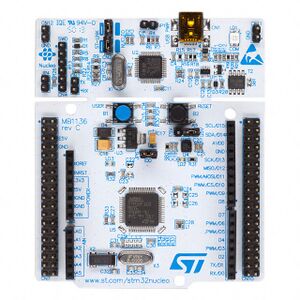Getting Started with STM32: Difference between revisions
Jump to navigation
Jump to search
No edit summary |
No edit summary |
||
| Line 1: | Line 1: | ||
Although this getting started class will work well for many of the STM32 processors and boards, we will focus on the NUCLEO-F103RB board with its STM32-F103RB processor.<br> | Although this getting started class will work well for many of the STM32 processors and boards, we will focus on the NUCLEO-F103RB board with its STM32-F103RB processor.<br> | ||
<br> | <br> | ||
[[File:NUCLEO_large.jpg|right|thumb]] | |||
<strong>64-Pin NUCLEO Board</strong><br> | <strong>64-Pin NUCLEO Board</strong><br> | ||
* Green LED, LD2, connected to PA5, illuminates when driven high | * Green LED, LD2, connected to PA5, illuminates when driven high | ||
| Line 8: | Line 9: | ||
* UART2 connects the target processor to the ST-Link, providing a USB COM port connection on the host computer. Uses PA2 for TX, and PA3 for RX. | * UART2 connects the target processor to the ST-Link, providing a USB COM port connection on the host computer. Uses PA2 for TX, and PA3 for RX. | ||
* ST-Link connects to TCK (PA14), TMS (PA13) | * ST-Link connects to TCK (PA14), TMS (PA13) | ||
https://www.st.com/en/evaluation-tools/nucleo-f103rb.html<br> | '''Board:''' https://www.st.com/en/evaluation-tools/nucleo-f103rb.html<br> | ||
'''Manual:''' https://www.st.com/resource/en/user_manual/um1724-stm32-nucleo64-boards-mb1136-stmicroelectronics.pdf<br> | |||
'''Schematic:''' https://www.st.com/resource/en/schematic_pack/nucleo_64pins_sch.zip<br> | |||
<strong>Processor: STM32F103RBT6</strong> | |||
* 128KB Flash | |||
* 20KB SRAM | |||
* 72MHz clock | |||
* Single-cycle multiplication and hardware division | |||
* 2.0 to 3.6 V application supply and I/Os | |||
* Within this part series, this is considered a "Medium-density device", | |||
and as such, has the following peripherals: | |||
* 3 USARTs | |||
* 3 16-bit timers | |||
* 2 SPIs, 2 I2Cs, USB, CAN, 1 PWM Timer, 2 ADCs | |||
Notes: | |||
"Low-density device" has fewer peripherals. | |||
"High-density device" has more peripherals. | |||
Revision as of 10:48, 8 March 2022
Although this getting started class will work well for many of the STM32 processors and boards, we will focus on the NUCLEO-F103RB board with its STM32-F103RB processor.

64-Pin NUCLEO Board
- Green LED, LD2, connected to PA5, illuminates when driven high
- Blue PushButton, B1, connects to PC13, grounding the signal when pressed
- 32,768Hz crystal oscillator, LSE, used for Real Time Clock (RTC)
- 8MHz HSE, is provided by the 8MHz crystal oscillator from the attached ST-Link, into PD0
- UART2 connects the target processor to the ST-Link, providing a USB COM port connection on the host computer. Uses PA2 for TX, and PA3 for RX.
- ST-Link connects to TCK (PA14), TMS (PA13)
Board: https://www.st.com/en/evaluation-tools/nucleo-f103rb.html
Manual: https://www.st.com/resource/en/user_manual/um1724-stm32-nucleo64-boards-mb1136-stmicroelectronics.pdf
Schematic: https://www.st.com/resource/en/schematic_pack/nucleo_64pins_sch.zip
Processor: STM32F103RBT6
* 128KB Flash * 20KB SRAM * 72MHz clock * Single-cycle multiplication and hardware division * 2.0 to 3.6 V application supply and I/Os * Within this part series, this is considered a "Medium-density device", and as such, has the following peripherals: * 3 USARTs * 3 16-bit timers * 2 SPIs, 2 I2Cs, USB, CAN, 1 PWM Timer, 2 ADCs Notes: "Low-density device" has fewer peripherals. "High-density device" has more peripherals.